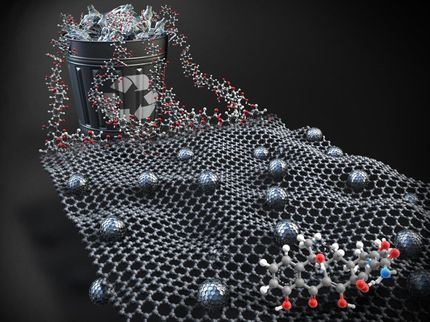Researchers Discover New Crystalline Calcium Phosphate
The mineral could be used in implantology, drug development or water treatment
A new type of crystalline calcium phosphate has been discovered and analysed in the laboratories of Leibniz University Hannover (LUH). Calcium orthophosphates, a group of biominerals, are a vital part of the human body and can be found in solid structures such as bones or teeth. Calcium orthophosphates crystallise in about a dozen different structures, most of which have already been identified in the 18th and 19th century. Since then, no new crystalline calcium phosphates were discovered. In collaboration with researchers from China, Sweden and Australia, a team at the LUH Institute of Inorganic Chemistry has now uncovered a new type of crystalline calcium phosphate.Their findings were published in the open access journal "Nature Communications".
Owing to its structure, the new crystalline calcium phosphate possesses unique properties, which distinguish it from similar calcium phosphates known to date: it is less stable in terms of thermodynamics. This means that it can transform itself into other calcium phosphate structures quite quickly. "Because of this property, it could be used in various medical applications or for improving the quality of water", explains Prof. Dr. Denis Gebauer from the Institute of Inorganic Chemistry.
For example, it could be used as an implant material. Metastable calcium phosphates are currently used as bone cement for attaching implants. Over time, the material is slowly absorbed and replaced by natural bone. Compared to conventional materials, the new mineral is composed of identical chemical components. However, it possesses a different structure. For this reason, cured cements composed of the new mineral could be much more similar to the structure of natural bone than conventional formulas, which could be beneficial in terms of structural integration as well as with regard to the body absorbing the cement.
Furthermore, the new crystalline calcium phosphate could be used as a drug carrier. "Due to its metastability, it demonstrates an increased capacity for holding pharmaceutical compounds", illustrates Professor Gebauer: "It facilitates uniting substances that do not belong together and we were able to demonstrate that the mineral is biologically compatible." In comparison to other known structures, compounds can be introduced into the body more easily.
Finally, the mineral could be used in water treatment. Due to its structural properties, the new and safe calcium phosphate could bind toxic substances in water more efficiently than currently used methods.
Moreover, the new mineral is expected to help researchers to gain a better understanding of certain diseases by providing new insights into the crystallisation mechanisms of calcium orthophosphates. This could enable conclusions to be drawn on the mechanisms of the early stages of arteriosclerosis, as well as the development of kidney and bladder stones or pathological mineralisation of muscle tissue in order to intervene during the intermediate stages of the diseases.
Most read news
Topics
Organizations
Other news from the department science

Get the chemical industry in your inbox
By submitting this form you agree that LUMITOS AG will send you the newsletter(s) selected above by email. Your data will not be passed on to third parties. Your data will be stored and processed in accordance with our data protection regulations. LUMITOS may contact you by email for the purpose of advertising or market and opinion surveys. You can revoke your consent at any time without giving reasons to LUMITOS AG, Ernst-Augustin-Str. 2, 12489 Berlin, Germany or by e-mail at revoke@lumitos.com with effect for the future. In addition, each email contains a link to unsubscribe from the corresponding newsletter.





























































